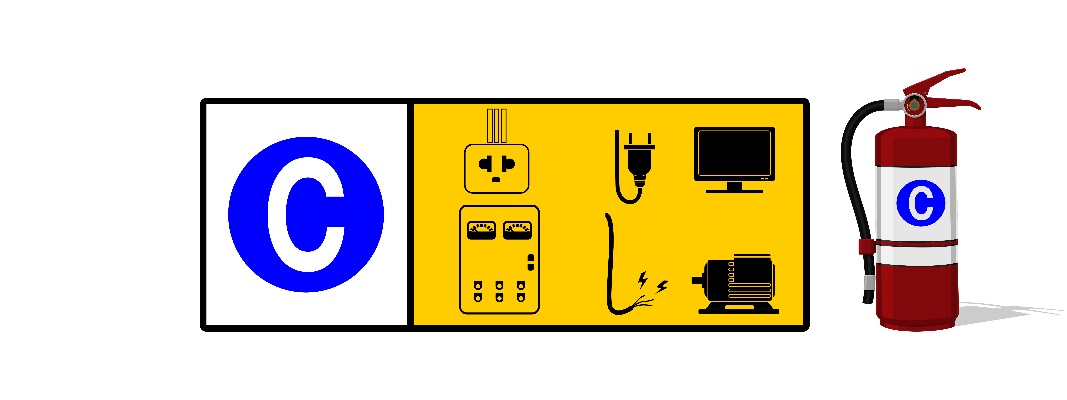
Fires can be complex, and not all fire extinguishers are effective on every fire. Electrical fires can become especially complicated and require proper handling and extinguishers.
Keep reading to learn more about the unique challenges of electrical, or Class C fires, and the Class C fire extinguishers that can be used to put them out.
WHAT ARE CLASS C FIRES?
A class C fire is one in which an energized electrical element is the cause of the fire. “Energized” means that the electrical component (whether electrical appliance, wiring, device, etc.) is connected to a power source.
Class C fires may be started from faulty wiring, a short circuit, damage to power cords, overloaded electrical outlets, overheated or overcharged devices, etc. As long as the equipment is connected to its power source, the power acts as a continuous source of ignition.
Wherever electrical equipment and/or wiring are charged, there is a risk of Class C fires.
Class C fires are particularly dangerous as the hazard remains until the power source is removed. Until then, there is also a risk for electrocution.
Water and water-based extinguishing agents cannot be used on Class C fires, as they conduct electrical current, thus potentially spreading the electricity and source of ignition, and could also result in the electrocution of the individual wielding the extinguisher.
If an extinguisher has a Class C rating, it means that the agent will not conduct electricity. But it is always best to disconnect the power source prior to fighting the fire.
A Class C fire extinguisher is used to extinguish a fire that is caused by an energized electrical element. If the source of power is removed from the fire, it no longer qualifies as a class C fire and becomes one of the other classes of fire. However, removing the power source is not always possible.
WHAT TYPES OF EXTINGUISHERS ARE RATED AS CLASS C FIRE EXTINGUISHERS?
Due to the unique hazards of Class C fires, it is extremely important to use only a Class C fire extinguisher to combat them.
As mentioned above, water-based extinguishers (with one exception, which will be listed momentarily) are not only ineffective but also dangerous to use.
Class C extinguishers use agents that are capable of separating the elements of the fire triangle: fuel, heat, and oxygen. This way, even if the power and ignition sources are still connected, the flames and heat can be suppressed and extinguished, hopefully, long enough for the power source to be disconnected.
If and when the power source is disconnected, and the fire has spread to other areas and fuel sources, the Class C extinguisher can be traded out for a more effective extinguisher (unless you are using an extinguisher that can handle multiple classes).
Types of extinguishers that are rated as Class C fire extinguishers include:
- Carbon Dioxide: CO2 extinguishers work by suffocating the fire, removing the oxygen element. They also remove the heat, as the discharge is extremely cold. CO2 fire extinguishers can also be used on Class B fires.
- Dry Chemical: These extinguishers work by interrupting the chemical reaction at work in the fire triangle.
The regular dry chemical extinguisher is rated for both Class C and B fires, while the multipurpose version can also be used on Class A fires. - Clean Agent: The halon and/or halocarbon agents used by clean agent extinguishers are effective on Class C and B fires, and sometimes class A fires (depending on the size of the extinguisher).
Similar to dry chemical extinguishers, the clean agents work by interrupting the fire triangle’s chemical reaction and/or by removing the fire’s heat. The key difference between a clean agent and a dry chemical is that the clean agent leaves no residue and can penetrate difficult to see and hard to reach areas. - Water Mist: The water mist extinguisher is a newer development and unlike a standard water-based extinguisher, can extinguish electrical hazards without the risk of electrical shock. These extinguishers work by removing the heat element of the fire triangle and are classified for both A and C fires.
The reason these can be used on Class C fires is because the extinguisher used de-ionized water which does not conduct electricity. Also, the water is expressed as a mist and not a stream which enhances the cooling and soaking characteristics and reduces scattering of burning materials.
It should be noted that once the flames of the fire are extinguished, an active fire hazard, as well as electrocution hazard, continues to be present as long as the faulty electronic equipment or element remains connected to its power source. If enough time is allowed to pass, the extinguishing agents could lose efficacy, and the fire could reignite. The area will not truly be safe until the power source is disconnected and the fire is completely extinguished.
DO YOU HAVE THE BEST FIRE EXTINGUISHER?
Nearly all residential and business settings contain electrical elements that could become Class C fire hazards. Does your home or business have an extinguisher capable of handling a Class C fire?
If you’re not sure whether you have the best fire extinguisher for your home or business, give the experts at Koorsen a call. They can help identify what your specific hazards are and which extinguishers will be most effective to protect you and your property.




